Presenters from some of the various STEAM Splash workshops discuss their activities in this in-depth look at STEAM Splash days.
Presenters from some of the various STEAM Splash workshops discuss their activities in this in-depth look at STEAM Splash days.
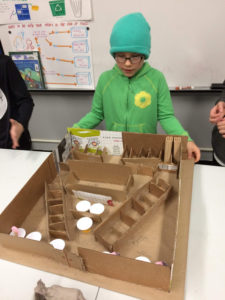 Grades 3-5 have been practicing collaboration in TikkunXDesign while designing and building their own schools. In small groups, students brainstormed important elements of a school, created a floor plan, and built up walls and furniture to create a demonstrative model. At each point along the way, students were asked to build upon each other’s ideas, come to agreements about how to proceed, and delegate tasks to each other.
Grades 3-5 have been practicing collaboration in TikkunXDesign while designing and building their own schools. In small groups, students brainstormed important elements of a school, created a floor plan, and built up walls and furniture to create a demonstrative model. At each point along the way, students were asked to build upon each other’s ideas, come to agreements about how to proceed, and delegate tasks to each other.
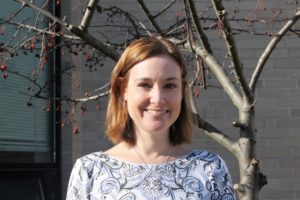 Meghan Cavanaugh joined JCDSRI’s faculty in September as our school social worker. Meghan has over a decade of experience working with children and families in schools as well as in home-based and office settings.
Meghan Cavanaugh joined JCDSRI’s faculty in September as our school social worker. Meghan has over a decade of experience working with children and families in schools as well as in home-based and office settings.
When asked about her impressions of JCDSRI, Meghan said that our school community is “positive and supportive — teachers reflect to students their strengths and talents, and model how to solve problems effectively and resolve conflicts fairly. Students are encouraged to think independently, create solutions to problems, and grow as learners.” She goes on to say that she is “most excited about helping students and teachers further integrate social-emotional learning into classrooms.”
Meghan is already making an impact focusing on four main areas:
Meghan is thrilled to be a part of the JCDSRI community and her presence is already felt. She is helping teachers further develop their developmentally appropriate, social and emotional curriculum and helping students learn mindfulness techniques to help them regulate their wiggly, squiggly selves in the classroom.
Fifth grader Ella Sinel won the SEEDlings student design challenge at StyleWeek Northeast this fall! In fact, the idea to open up the event to youngsters came from Ella. According to founder and CEO, Rosanna Ortiz, Ella “was very persistent in getting a hold of me because she wanted me to look at her sketches because she wanted to be a StyleWeek designer,” Ortiz said. “It was funny because this little girl was emailing every email address for me she could find. At first, I thought it was a joke.”
Ella’s passion for fashion designing was encouraged last year by fourth grade teacher, Melynda Silva, during Genius Hour — a year-long project that allows students to identify and pursue a personal passion.
Read more in the Voice and Herald below:
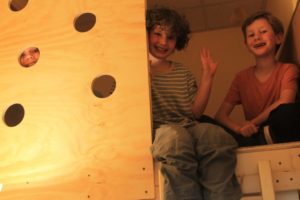 May 18th was a very exciting day for the JCDSRI third grade class (popularly known as Thirdopolis). The day included the culmination of a year-long TikkunXDesign project that focused on their “Grow Room,” a quiet alcove within the classroom. The Grow Room was initially conceived as a space where both children and plants would grow – children would “grow” their social/emotional skills surrounded by plants under a set of grow lights. Students would be responsible for caring for the plants and learned how to track their growth by taking scientific measurements. At the same time, the alcove would provide a calming space for conflict resolution and for students to take a break if they felt the need to “recharge.” The idea for the Grow Room was based on our school’s approach to social/emotional learning, as well as on studies that show that being surrounded by green growing things can contribute to a calm state of mind.
May 18th was a very exciting day for the JCDSRI third grade class (popularly known as Thirdopolis). The day included the culmination of a year-long TikkunXDesign project that focused on their “Grow Room,” a quiet alcove within the classroom. The Grow Room was initially conceived as a space where both children and plants would grow – children would “grow” their social/emotional skills surrounded by plants under a set of grow lights. Students would be responsible for caring for the plants and learned how to track their growth by taking scientific measurements. At the same time, the alcove would provide a calming space for conflict resolution and for students to take a break if they felt the need to “recharge.” The idea for the Grow Room was based on our school’s approach to social/emotional learning, as well as on studies that show that being surrounded by green growing things can contribute to a calm state of mind.
Much of the year in TikkunXDesign was spent applying the Design Process to improving the Grow Room. Our TikkunXDesign Director, Tiferet Rose, and third graders brainstormed, conducted interviews, built several different models — all the while making sure that their ideas reflected the purpose of the space. In the end, three different improvements were chosen: a loft addition, new bean bag chairs and a curtain to make the space more private.
Enter Brown University student Katya Scocimara who worked with Thirdopolis during our school’s STEAM Splash event. Katya had a wonderful experience teaching our students about Biomimicry and expressed interest in completing her final project for her engineering Design Studio at JCDSRI. Given Katya’s interests and background, Thirdopolis’ grow room emerged as the best fit for all involved.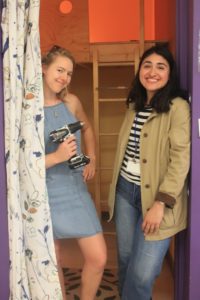
After an initial idea-sharing session with third graders, Katya and her team were able to design, build and install a loft in only three short weeks. This month, Thirdopolis eagerly welcomed the loft and newly designed Grow Room into their classroom. Final touches will soon be added: a mural, pulley system and welcome sign. Third grade teacher, Joe Mirsky, led the Thirdopolans through a process to lay ground rules for the new space, to keep it safe, fair and fun, so students can continue to use it responsibly throughout their busy days.
This project is a wonderful example of the dynamic collaboration between classroom teachers, TikkunXDesign and our school’s Brown/RISD partners. Third grade students are very excited about the loft. While acknowledging how much help they received both from Katya and their teachers, they also have a clear sense of ownership over the entire process — and therefore the space itself.
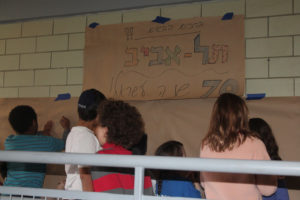 Our school-wide celebration of Israel’s Independence Day was very active and kef (fun)! In honor of Israel’s 70th birthday, students played Israeli games and participated in Israeli folk dancing during recess. Students “visited” a variety of places in Israel as they traveled around school participating in different stations. We had an all-school trivia competition, Jewperdy, in Jerusalem. They also visited Jaffa, where children were challenged to an orange-picking/sorting relay, and Tel Aviv, where our artists created graffiti on the city’s “walls.” Finally, students created their own mosaics similar to those found in the Israeli city of Tzipori.
Our school-wide celebration of Israel’s Independence Day was very active and kef (fun)! In honor of Israel’s 70th birthday, students played Israeli games and participated in Israeli folk dancing during recess. Students “visited” a variety of places in Israel as they traveled around school participating in different stations. We had an all-school trivia competition, Jewperdy, in Jerusalem. They also visited Jaffa, where children were challenged to an orange-picking/sorting relay, and Tel Aviv, where our artists created graffiti on the city’s “walls.” Finally, students created their own mosaics similar to those found in the Israeli city of Tzipori.
Each class collaboratively wrote a thoughtful poem reflecting their Hopes and Dreams for Israel. The poems were shared at an all-school Yon Ha’atzmaut assembly. Here is third grade’s class poem:
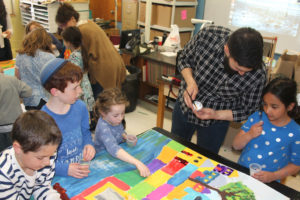 FOR YOU ISRAEL כיתה ג HOPES . . .
FOR YOU ISRAEL כיתה ג HOPES . . .
YOU ALWAYS REMAIN A PEACEFUL COUNTRY.
FOR YOU ISRAEL כיתה ג HOPES . . .
YOU WILL BE AN EXAMPLE FOR THE WORLD.
FOR YOU ISRAEL כיתה ג HOPES . . .
YOU WILL HAVE NO MORE WARS WITH OTHER COUNTRIES.
FOR YOU ISRAEL כיתה ג HOPES . . .
YOU WILL ALWAYS HAVE A STRONG HEALTHY ARMY.
Our school-wide Purim celebration was filled with costume parades, games, hamantaschen baking and more! Leading up to Purim, students studied the holiday story from Megillat Esther (the Scroll of Esther) and each class decorated its door with a scene from the story. Students filmed themselves acting out the scene from their classroom door. On Purim, children visited each other’s classes and upon entering were treated to the student-made videos that brought the Purim story to life.
Older students chanted from the Book of Esther for the whole community. In the afternoon, we assembled bags with toiletries for people in need and everyone exchanged Mishloach Manot, goody-filled bags, to complete the celebration!
Why do we give “non-traditional” homework in third grade?
Our goal is to make sure that student learning outside of school is enriching and that our students have opportunities to pursue their own interests. We think that homework should allow students to deepen their understanding as they delve into subjects that are of interest to them.
What is “non-traditional” homework?
Our “non-traditional” homework works on a four-week cycle.
Here are some examples:
Here is our song list for Zimriyah 2017!
Next to each song title is which grades will be singing it. We’ll be using these recordings to practice for the performance on May 25th!
Second grade students were ecstatic to meet their preschool buddies from the Jewish Community Center. We walked down the street and around the corner and were greeted by a wonderful group of educators and adorable students. We played games and our young second grade authors got to read their How-To books to their new friends. They laughed, they began to bond, and most of all made memories. We cannot wait for our next get together.